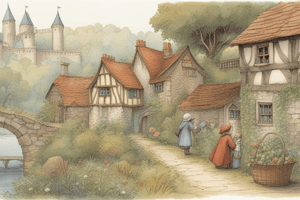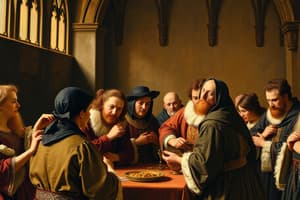Podcast
Questions and Answers
What was the primary purpose of Craft Guilds?
What was the primary purpose of Craft Guilds?
- To protect and promote the financial interests of their members (correct)
- To create a hierarchy of artisans based on skill
- To promote competition among artisans
- To restrict apprenticeship to only a select few
What was the typical structure of a Craft Guild?
What was the typical structure of a Craft Guild?
- An assembly of all members, with a council of advisors
- A single council of advisors
- A hierarchy of Masters, Journeymen, and Apprentices (correct)
- An inner circle of Master Craftsmen only
What was the result of State intervention in Craft Guilds from the 15th century onwards?
What was the result of State intervention in Craft Guilds from the 15th century onwards?
- Increased autonomy for guilds
- Targeting of key areas of guild policy (correct)
- Stricter rules for apprenticeship
- Dissolution of guilds
Why was it rare for Craft Guilds to achieve a complete monopoly over their profession?
Why was it rare for Craft Guilds to achieve a complete monopoly over their profession?
What was the role of the assembly of all members in a Craft Guild?
What was the role of the assembly of all members in a Craft Guild?
When did the development of Craft Guilds largely occur in Europe?
When did the development of Craft Guilds largely occur in Europe?
What led to the decline of craft guilds from the late 16th century onwards?
What led to the decline of craft guilds from the late 16th century onwards?
In which year were craft guilds abolished in France?
In which year were craft guilds abolished in France?
What was the reaction against the mechanization of craft guilds?
What was the reaction against the mechanization of craft guilds?
Which of the following was NOT a type of art mastered in Eastern Asia?
Which of the following was NOT a type of art mastered in Eastern Asia?
What was the result of the decline of craft guilds?
What was the result of the decline of craft guilds?
In which country were craft guilds abolished in 1840?
In which country were craft guilds abolished in 1840?
What was the outcome of the idea of producing art for the masses?
What was the outcome of the idea of producing art for the masses?
What was established in the 1880s to promote Arts and Crafts ideas?
What was established in the 1880s to promote Arts and Crafts ideas?
What is the main issue with establishing standards of training and production in crafts?
What is the main issue with establishing standards of training and production in crafts?
How do craftworkers function today?
How do craftworkers function today?
Why do craftspeople not receive the same recognition as fine artists?
Why do craftspeople not receive the same recognition as fine artists?
What is the difference between craft activities and fine arts?
What is the difference between craft activities and fine arts?
What is the difference between knitting and crocheting?
What is the difference between knitting and crocheting?
What is the primary difference between weaving and tapestry?
What is the primary difference between weaving and tapestry?
What is felting in the context of textiles?
What is felting in the context of textiles?
What is quilting in the context of textiles?
What is quilting in the context of textiles?
What is the term for the threads that run longitudinally in a woven fabric?
What is the term for the threads that run longitudinally in a woven fabric?
What is tapestry traditionally made on?
What is tapestry traditionally made on?
What was the primary concern of the Arts and Crafts Movement?
What was the primary concern of the Arts and Crafts Movement?
What was the key principle behind the Arts and Crafts Movement's design philosophy?
What was the key principle behind the Arts and Crafts Movement's design philosophy?
Who was the founder of the Arts & Crafts Exhibition Society in 1888?
Who was the founder of the Arts & Crafts Exhibition Society in 1888?
What event in 1851 led to the foundation of the Victoria and Albert Museum?
What event in 1851 led to the foundation of the Victoria and Albert Museum?
What was the main influence of John Ruskin's ideas on the Arts and Crafts Movement?
What was the main influence of John Ruskin's ideas on the Arts and Crafts Movement?
What company was founded by William Morris to promote the recreation of hand industry in a machine age?
What company was founded by William Morris to promote the recreation of hand industry in a machine age?
Flashcards are hidden until you start studying
Study Notes
Craft Guilds (c.1250-1850)
- Craft Guilds originated in medieval Europe as occupational associations consisting of artisans, suppliers, retailers, and wholesale merchants involved in a specific branch of industry or commerce.
- Guilds varied little in their general organization, with an assembly of all members, a council of advisors, and top officials controlling the guild.
- A typical Guild was divided into three categories: Masters, Journeymen, and Apprentices.
- The main economic aim of craft guilds was to achieve a complete monopoly over everyone involved in the profession, but this was rarely achieved due to competing guilds and state intervention.
- From the 15th century onwards, state intervention targeted rules regarding apprenticeship and key areas of guild policy, leading to a decline in the power and activity of craft guilds from the late 16th century onwards.
Decline of Craft Guilds and the Emergence of Mass-Production
- The Industrial Revolution introduced standardization and mass-production techniques, further accelerating the decline of craft guilds.
- Regulated companies and other associations emerged, contributing to the decline of craft guilds.
- Guilds were finally abolished in various countries: France (1791), Rome (1907), Spain (1840), England (1835), Austria and Germany (1860), and Italy (1864).
- The disappearance of craft guilds marked the end of master-craftsmanship and the emergence of machine-tool dexterity in factories and workshops.
East Asian Arts and Crafts
- Asian art from India, China, Korea, and Japan is known for its mastery of different art forms.
- Examples of art forms mastered in Eastern Asia include lacquerware, jade carving, bronzes, pottery, porcelain, Buddhist sculpture, silks, and other textiles.
Arts and Crafts Movement
- The Arts and Crafts Movement emerged in late Victorian times as a reaction against the mechanization of crafts.
- The movement aimed to promote good design and craftsmanship, emphasizing "honesty" in producing products that showed clearly what they were made of and how they worked.
- The movement's name came from the Arts & Crafts Exhibition Society, founded in 1888, and its origins date back to the 1850s ideas of John Ruskin.
Artists Versus Craftspeople
- The resurgence of handicrafts and decorative arts has led to a blurring of the lines between artists and craftspeople.
- Many craft activities can be distinguished from the fine arts, but a large number of craftspeople creating one-off pieces consider themselves artists.
- There is no logical reason to classify unique pieces of pottery, stained glass, wood-carving, or textile as "craft products" rather than "works of art."
Textile Arts
- Felt is probably the world's oldest textile, with a traditional "wet" felting technique and now also needle felting.
- Knitting forms a fabric or garment by interlacing yarn or thread in connected loops with needles.
- Crochet uses a single hook to hook the loops together directly on the piece, making it easier to work with than knitting.
- Quilting is the process of joining a minimum of three layers of fabric together through stitching or mechanically with a sewing machine.
- Tapestry is a form of textile art, traditionally woven by hand on a loom, with weft-faced weaving where all the warp threads are hidden in the completed work.
- Weaving is a method of textile production where two distinct sets of yarns or threads are interlaced at right angles to form a fabric or cloth.
Studying That Suits You
Use AI to generate personalized quizzes and flashcards to suit your learning preferences.




